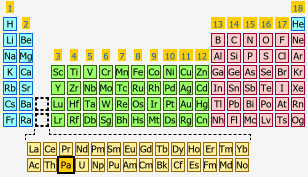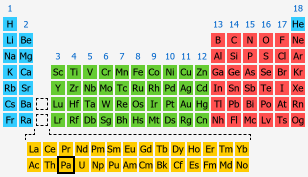References (Click the  next to a value above to see complete citation information for that entry)
next to a value above to see complete citation information for that entry)
Bernstein, Jeremy. Plutonium: A History of the World's Most Dangerous Element. Ithaca, NY: Cornell University Press, 2007.
Campbell, J. L. "Fluorescence Yields and Coster–Kronig Probabilities for
the Atomic L Subshells. Part II: The L1 Subshell Revisited." Atomic Data and Nuclear Data Tables, volume 95, number 1, 2009, pp. 115–124. doi:10.1016/j.adt.2008.08.002
Campbell, J. L. "Fluorescence Yields and Coster–Kronig Probabilities for
the Atomic L Subshells." Atomic Data and Nuclear Data Tables, volume 85, number 2, 2003, pp. 291–315. doi:10.1016/S0092-640X(03)00059-7
Cardarelli, François. Materials Handbook: A Concise
Desktop Reference, 2nd edition. London: Springer–Verlag, 2008.
Connelly, Neil G., Ture Damhus, Richard M. Hartshorn, and Alan T. Hutton. Nomenclature of Inorganic Chemistry: IUPAC Recommendations 2005. Cambridge: RSC Publishing, 2005.
Cambridge: RSC Publishing, 2005.
Cordero, Beatriz, Verónica Gómez, Ana E. Platero-Prats, Marc Revés, Jorge Echeverría, Eduard Cremades, Flavia Barragán, and Santiago Alvarez. "Covalent Radii Revisited." Dalton Transactions, number 21, 2008, pp 2832–2838. doi:10.1039/b801115j
de Podesta, Michael. Understanding the Properties of Matter, 2nd edition. London: Taylor & Francis, 2002.
Debessai, M., J. J. Hamlin, and J. S. Schilling. "Comparison of the Pressure Dependences of Tc in the Trivalent d-Electron Superconductors Sc, Y, La, and Lu up to Megabar Pressures." Physical Review B, volume 78, number 6, 2008, pp. 064519–1 to 064519–10. doi:10.1103/PhysRevB.78.064519
Dronskowski, Richard. Computational Chemistry of Solid State Materials. Weinheim, Germany: WILEY-VCH Verlag GmbH & Co. KGaA, 2005.
Emsley, John. Nature's Building Blocks: An A-Z Guide to the Elements. Oxford: Oxford University Press, 2003.
Emsley, John. The Elements, 3rd edition. Oxford: Oxford University Press, 1998.
Firestone, Richard B. Table of Isotopes, 8th edition, volume 2. Edited by Virginia S. Shirley, with assistant editors Coral M. Baglin, S. Y. Frank Chu, and Jean Zipkin. New York: John Wiley & Sons, Inc.,
1996.
Greenwood, N. N., and A. Earnshaw. Chemistry of the Elements, 2nd edition. Burlington, MA: Butterworth-Heinemann, 1997.
Greenwood, N. N., and A. Earnshaw. Chemistry of the Elements, 2nd edition. Oxford: Butterworth-Heinemann, 1997.
Gwyn Williams. Electron Binding Energies. http://www.jlab.org/~gwyn/ebindene.html . Accessed on April 30, 2010.
. Accessed on April 30, 2010.
Ho, C. Y., R. W. Powell, and P. E. Liley. "Thermal Conductivity of the Elements: A Comprehensive Review." Journal of Physical and Chemical Reference Data, volume 3, supplement 1, 1974, pp. I–1 to I–796.
Journal of Physical and Chemical Reference Data, volume 3, supplement 1, 1974, pp. I–1 to I–796.
Horvath, A. L. "Critical Temperature of Elements and the Periodic System." Journal of Chemical Education, volume 50, number 5, 1973, pp. 335–336. doi:10.1021/ed050p335
Huheey, James E., Ellen A. Keiter, and Richard L Keiter. Inorganic Chemistry: Principles of Structure and Reactivity, 4th edition. New York: HarperCollins College Publishers, 1993.
Indelicato, P., J. P. Santos, S. Boucard, and J.-P. Desclaux. "QED and
Relativistic Corrections in Superheavy Elements." The European Physical Journal D - Atomic, Molecular, Optical and Plasma Physics, volume 45, number 1, 2007, pp. 155–170. doi:10.1140/epjd/e2007-00229-y
Jr., Elbert J. Little,, and Mark M. Jones. "A Complete Table of Electronegativities." Journal of Chemical Education, volume 37, number 5, 1960, pp. 231–233. doi:10.1021/ed037p231
Kaltsoyannis, Nikolas, and Peter Scott. The f Elements. Oxford: Oxford University Press, 1999.
King, H. W. "Temperature-Dependent Allotropic Structures of the Elements." Bulletin of Alloy Phase Diagrams, volume 3, number 2, 1982, pp. 275–276. doi:10.1007/BF02892394
Kittel, Charles. Introduction to Solid State Physics, 8th edition. Hoboken, NJ: John Wiley & Sons, Inc, 2005.
Konings, Rudy J. M., and Ondrej Beneš. "The Thermodynamic Properties of the f-Elements and Their Compounds. I. The Lanthanide and Actinide Metals." Journal of Physical and Chemical Reference Data, volume 39,
number 4, 2010, pp. 043102–1 to 043102–47. doi:10.1063/1.3474238
Lide, David R., editor. CRC Handbook of Chemistry and Physics, 88th edition. Boca Raton, Florida: Taylor & Francis Group,
2008.
Marshall, James L. Discovery of the Elements: A Search for the Fundamental Principles of the Universe, 2nd edition. Boston, MA: Pearson Custom Publishing, 2002.
Martin, W. C. "Electronic Structure of the Elements." The European Physical Journal C — Particles and Fields, volume 15, number 1–4, 2000, pp. 78–79. doi:10.1007/BF02683401
Miessler, Gary L., and Donald A. Tarr. Inorganic Chemistry, 3rd edition. Upper Saddle River, NJ: Pearson Prentice Hall, 2004.
Nagle, Jeffrey K. "Atomic Polarizability and Electronegativity." Journal of the American Chemical Society, volume 112,
number 12, 1990, pp. 4741–4747. doi:10.1021/ja00168a019
Nobel Foundation. Frederick Soddy: The Nobel Prize in Chemistry 1921. http://nobelprize.org/nobel_prizes/chemistry/laureates/1921/soddy-bio.html . Accessed on July 15, 2009.
. Accessed on July 15, 2009.
Nobel Foundation. Otto Hahn: The Nobel Prize in Chemistry 1944. http://nobelprize.org/nobel_prizes/chemistry/laureates/1944/hahn-bio.html . Accessed on July 15, 2009.
. Accessed on July 15, 2009.
Oxtoby, David W., H. P. Gillis, and Alan Campion. Principles of Modern Chemistry, 6th edition. Belmont, CA:
Thomson Brooks/Cole, 2008.
Pauling, Linus. The Nature of the Chemical Bond, 3rd edition. Ithaca, NY: Cornell University Press, 1960.
Pekka Pyykkö. Self-Consistent, Year-2009 Covalent Radii. http://www.chem.helsinki.fi/~pyykko/Radii09.pdf . Accessed on November 20, 2010.
. Accessed on November 20, 2010.
Prohaska, Thomas, Johanna Irrgeher, Jacqueline Benefield, John K. Böhlke, Lesley A. Chesson, Tyler B. Coplen, Tiping Ding, Philip J. H. Dunn, Manfred Gröning, Norman E. Holden, Harro A. J. Meijer, Heiko Moossen, Antonio Possolo, Yoshio Takahashi, Jochen Vogl, Thomas Walczyk, Jun Wang, Michael E. Wieser, Shigekazu Yoneda, Xiang-Kun Zhu, and Juris Meija. "Standard Atomic Weights of the Elements 2021 (IUPAC Technical Report)." Pure and Applied Chemistry, volume 94, number 5, 2022, pp. 573–600. doi:10.1515/pac-2019-0603
Pure and Applied Chemistry, volume 94, number 5, 2022, pp. 573–600. doi:10.1515/pac-2019-0603
Pyykkö, Pekka, and Michiko Atsumi. "Molecular Double-Bond Covalent Radii for Elements Li-E112." Chemistry - A European Journal, volume 15, number 46, 2009, pp. 12770–12779. doi:10.1002/chem.200901472
Pyykkö, Pekka, and Michiko Atsumi. "Molecular Single-Bond Covalent Radii for Elements 1-118." Chemistry - A European Journal, volume 15, number 1, 2009, pp. 186–197. doi:10.1002/chem.200800987
Pyykkö, Pekka, Sebastian Riedel, and Michael Patzschke. "Triple-Bond Covalent Radii." Chemistry - A European Journal, volume 11, number 12, 2005, pp. 3511–3520. doi:10.1002/chem.200401299
Quadbeck-Seeger, Hans-Jürgen. World of the Elements: Elements of the World. Translated by José Oliveira. Bad Dürkheim, Germany: Wiley-VCH Verlag GmbH & Co. KGaA, 2007.
Ringnes, Vivi. "Origin of the Names of Chemical Elements." Journal of Chemical Education, volume 66, number 9, 1989,
pp. 731–738. doi:10.1021/ed066p731
Rohrer, Gregory S. Structure and Bonding in Crystalline Materials. Cambridge: Cambridge University Press, 2001.
Sansonetti, J. E., and W. C. Martin. "Handbook of Basic Atomic Spectroscopic Data." Journal Of Physical And Chemical Reference Data, volume 34, number 4, 2005, pp. 1559–2259. doi:10.1063/1.1800011
Journal Of Physical And Chemical Reference Data, volume 34, number 4, 2005, pp. 1559–2259. doi:10.1063/1.1800011
Scientific Group Thermodata Europe (SGTE). Pure Substances: Part 1—Elements and Compounds from AgBr to Ba3N2. Edited by I. Hurtado and D. Neuschütz. Berlin: Springer-Verlag, 1999. doi:10.1007/10652891_3
Seaborg, Glenn T., and Walter D. Loveland. The Elements Beyond Uranium. New York: John Wiley & Sons, Inc., 1990.
Shannon, R. D. "Revised Effective Ionic Radii and Systematic Studies of Interatomic Distances in Halides and Chalcogenides." Acta Crystallographica Section A, volume 32, number 5, 1976, pp. 751–767. doi:10.1107/S0567739476001551
Silbey, Robert J., Robert A. Alberty, and Moungi G. Bawendi. Physical Chemistry, 4th edition. Hoboken, NJ: John Wiley & Sons, Inc., 2005.
Sime, Ruth Lewin. Lise Meitner: A Life in Physics. Berkeley, CA: University of California Press, 1996.
Singman, Charles N. "Atomic Volume and Allotropy of the Elements." Journal of Chemical Education, volume 61, number 2, 1984, pp. 137–142. doi:10.1021/ed061p137
Slater, J. C. "Atomic Radii in Crystals." The Journal of Chemical Physics, volume 41, number 10, 1964, pp. 3199–3204. doi:10.1063/1.1725697
Smith, Derek W. "Electronegativity in Two Dimensions: Reassessment and Resolution of the Pearson-Pauling Paradox." Journal of Chemical Education, volume 67, number 11, 1990, pp. 911–914. doi:10.1021/ed067p911
Smith, Derek W. Inorganic Substances: A Prelude to the Study of Descriptive Inorganic Chemistry. Cambridge: Cambridge University Press, 1990.
Stewart, G. R. "Measurement of low-temperature specific heat." Review of Scientific Instruments, volume 54, number 1, 1983, pp. 1–11. doi:10.1063/1.1137207
Stewart, G. R. "Measurement of Low-Temperature Specific Heat." Review of Scientific Instruments, volume 54, number 1, 1983, pp. 1–11. doi:10.1063/1.1137207
Tari, A. The Specific Heat of Matter at Low Temperatures. London: Imperial College Press, 2003.
Vainshtein, Boris K., Vladimir M. Fridkin, and Vladimir L. Indenbom. Structure of Crystals, 2nd edition. Modern Crystallography 2. Edited by Boris K. Vainshtein, A. A. Chernov, and L. A. Shuvalov. Berlin: Springer-Verlag, 1995.
Waber, J. T., and Don T. Cromer. "Orbital Radii of Atoms and Ions." Journal of Chemical Physics, volume 42, number 12, 1965, pp. 4116–4123. doi:10.1063/1.1695904
Weeks, Mary Elvira, and Henry M. Leicester. Discovery of
the Elements, 7th edition. Easton, PA: Journal of Chemical Education, 1968.
Wieser, Michael E., and Tyler B. Coplen. "Atomic weights of the elements 2009 (IUPAC Technical Report)." Pure and Applied
Chemistry, volume 83, number 2, 2011, pp. 359–396. doi:10.1351/PAC-REP-10-09-14
Pure and Applied
Chemistry, volume 83, number 2, 2011, pp. 359–396. doi:10.1351/PAC-REP-10-09-14
Yaws, Carl L. The Yaws Handbook of Physical Properties for Hydrocarbons and Chemicals. Houston, TX: Gulf Publishing Company, 2005.























































 next to a value above to see complete citation information for that entry)
next to a value above to see complete citation information for that entry)

 Cambridge: RSC Publishing, 2005.
Cambridge: RSC Publishing, 2005.

 . Accessed on April 30, 2010.
. Accessed on April 30, 2010. Journal of Physical and Chemical Reference Data, volume 3, supplement 1, 1974, pp. I–1 to I–796.
Journal of Physical and Chemical Reference Data, volume 3, supplement 1, 1974, pp. I–1 to I–796.






 . Accessed on July 15, 2009.
. Accessed on July 15, 2009. . Accessed on July 15, 2009.
. Accessed on July 15, 2009. . Accessed on November 20, 2010.
. Accessed on November 20, 2010. Pure and Applied Chemistry, volume 94, number 5, 2022, pp. 573–600. doi:10.1515/
Pure and Applied Chemistry, volume 94, number 5, 2022, pp. 573–600. doi:10.1515/




 Journal Of Physical And Chemical Reference Data, volume 34, number 4, 2005, pp. 1559–2259. doi:10.1063/
Journal Of Physical And Chemical Reference Data, volume 34, number 4, 2005, pp. 1559–2259. doi:10.1063/








 Pure and Applied
Chemistry, volume 83, number 2, 2011, pp. 359–396. doi:10.1351/
Pure and Applied
Chemistry, volume 83, number 2, 2011, pp. 359–396. doi:10.1351/


